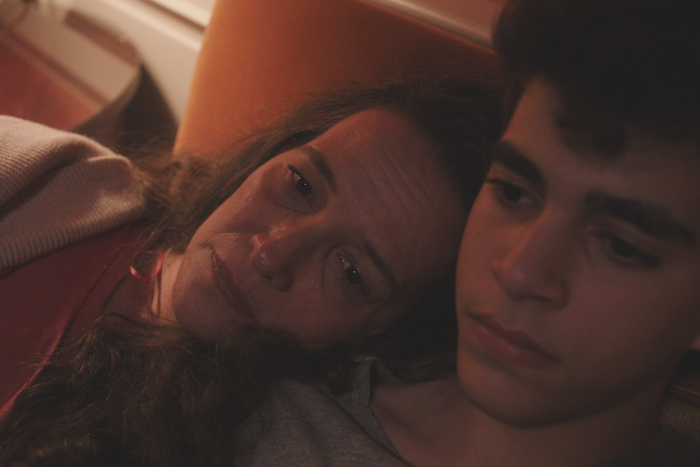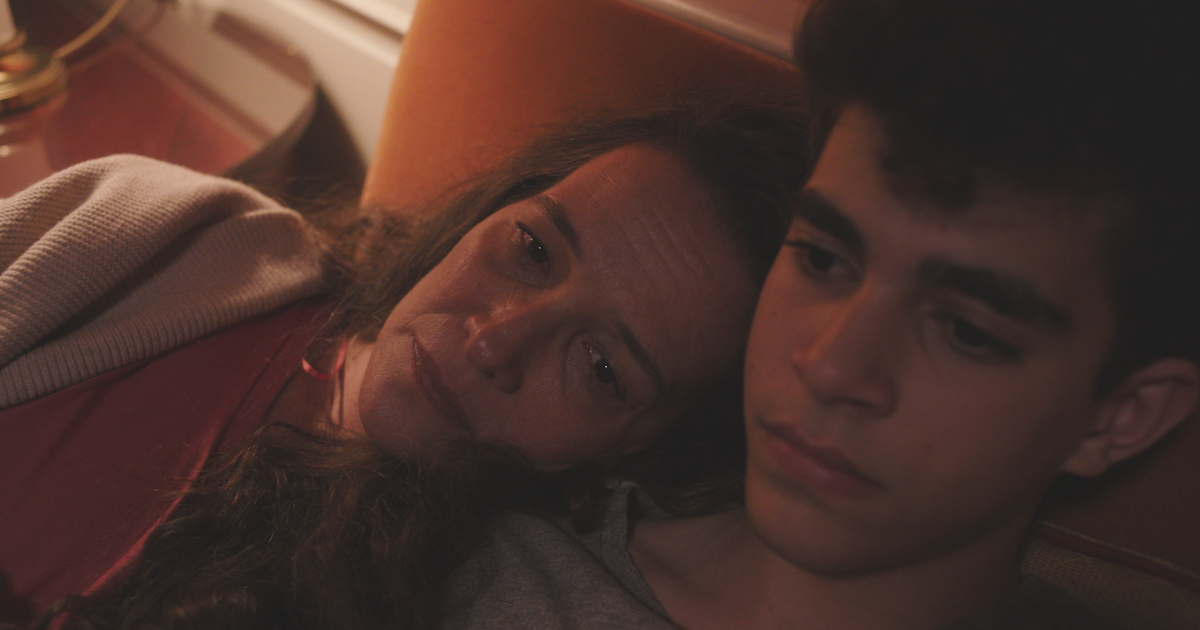
Yael Abecassis as Sabine Taasa in One Day in October.
Photo: HBO Max
In the fourth episode of One Day in October, a French journalist interviews Sabine Taasa, a victim of the October 7 Hamas attack on Israel who lost her husband and eldest son. The scene recreates the real-life Taasa’s memories of a press tour she took in the aftermath of that day. “Do you think this attack came in a particular context?” the journalist asks Taasa, played by Yael Abecassis. “Excuse me?” she asks. “This story has two sides,” the journalist says. “Can you explain why you were attacked?” Taasa looks at him in blank, exhausted disgust and then looks straight into the camera. “Do you want to know what I saw on the road when we were rescued? How many bodies of naked women? Dead? In torn underwear?” “But from a broader perspective …,” the journalist starts again. “I came here to talk, to tell my story. What happened to me,” Taasa says. “If those are the questions you’re asking me, I’m stopping this interview. Thank you. Good night.”
One Day in October, a Fox Entertainment production now on HBO Max, is one of two new scripted streaming series released in the United States on the second anniversary of the October 7 attack. The other, a Keshet Media production available on Paramount+, is called Red Alert. Both series drop viewers into the horror of that day. Families huddled in safe rooms assume the sirens will end soon but grow alarmed as the sound of gunfire builds. People caught outside when the attack occurs take cover under trees or in temporary shelters as Hamas terrorists sprint past. One Day in October spends an episode locked inside a portable toilet with Gali Amar and Amit Amar, who hid for hours at the Nova music festival. One of the central families in Red Alert, the Yahalomis, try to shelter in their home but are found and abducted by Hamas.
Over and over, Red Alert and One Day in October emphasize evidence and verisimilitude and fact, inserting real footage into their fictional recreations, with One Day in October especially shifting back and forth between security footage, videos shot on cell phones, and painstaking reconstructions of the same characters and scenes. (Notes onscreen designate the real footage from the reproductions.) Although some characters in Red Alert have pseudonyms, both series end with images of the actors embracing their real-life counterparts. These sequences include footage of the survivors on set watching the proceedings, adjusting costumes or nodding in recognition of sets. Each episode of One Day in October ends on shots of the survivors staring into the camera. These images have a purpose, and both series reach for that goal in every frame. This day was a nightmare, they remind viewers. Over 1,000 people were murdered and hundreds more abducted. What you’re witnessing happened to real people like Sabine Taasa.
The parallels between Red Alert and One Day in October, both Israeli productions acquired by American streaming platforms, make it easy to notice how each storytelling decision serves to reinforce an incomplete narrative. Neither series spends time on who the attackers are, or why they might be attacking. Neither series provides historical background nor do they confront the aftermath of October 7. The few times One Day in October tries to expand to the press’s coverage of the aftermath or tell a story outside of Israel, the narrative begins to splinter. The “context” the journalist mentioned draws focus again. What is it, and why is Taasa so furious with her for bringing it up?
Both series do attempt to consider October 7 outside of the Jewish Israeli experience with a storyline about the suffering and grief Arabic families also experienced during the attack. In Red Alert, Hamas terrorists on motorcycles shoot blindly into Ayoub’s (Hisham Sulliman) car, killing his wife Nur and sending Ayoub running with his infant son to shelter in a nearby shed. Devastated and overwhelmed, he shushes his baby so Hamas fighters won’t hear them, then falls to his knees when Israeli soldiers finally arrive, begging them to believe that he’s a civilian. A similar story plays out in One Day in October, when a Jewish Israeli woman hides from the attack with a Bedouin kibbutz worker who’s initially suspected of affiliation with Hamas. Just as with the accounts of Jewish victims, both series emphasize realism and evidence. Photos of the real Ayoub, who uses a pseudonym in the series, and footage of his family, their faces blurred as they kneel to kiss his wife’s grave, appear in the end credits of Red Alert.
But each show’s commitment to realism only extends to a certain point. There’s little effort to explore the complex identities of Arabic people who live in Israel or to wrestle with the distinctions between them, Palestinians in Gaza, and Hamas terrorists. Everyone in Israel is depicted as a victim of the attack regardless of religion or heritage. And both shows cast Sulliman, an Arab-Israeli actor, in the same role of an Arabic father trying to rescue his children. There is no analogous curiosity about the stories of Palestinian civilians in the Gaza-set episode of One Day in October, which follows Israeli hostage Omer Shem Tov during hundreds of days of Hamas imprisonment. The only Gazans portrayed in One Day are his violent captors. Neither series engages with the idea that thousands of Palestinians have been murdered in the two years since, or that Israel spent years blocking humanitarian aid from entering Gaza, or that Gaza is now home to the world’s highest per-capita population of child amputees. “If those are the questions you’re asking me, I’m stopping this interview,” Taasa tells the French journalist. Those facts are outside the scope.
One Day in October and Red Alert are compelling vehicles for their fundamental message: October 7 was abominable. They hammer this argument into every choice, with no space for uncertainty. The smoke, the fires, the gunshots, the chaos, the terror, the grief — all of it appears in gut-wrenching detail. But these shows are not exactly memorials, in the mode of United 93 or 9/11: One Day in America. They focus almost entirely on the survivors of the attack rather than remembering the dead or the missing — the episode about Taasa is more about her than it is her son or husband. As a result, they imply that these survivors are still at risk, that they still need protecting, and that overwhelming force is a justified response. Israel was the victim of a terrorist attack on this specific day, and any other frame of analysis should be discarded. “We await their prompt return,” the closing credits of one episode of One Day in October state, a reference to the hostages. It presumes an inclusive “we.” We, the filmmakers and the audience, feel for the hostages, and so we are united in our opinion of the entire crisis. We must be, after what these episodes depict.
Red Alert and One Day in October are both being released in the United States at a time when this presumptive “we” is more presumptive than ever. Public polling suggests that approval for Israel’s actions in Gaza has never been lower. Fifty-five percent of Americans report that they’re concerned about Palestinian starvation. Only 35 percent say they have a favorable view of the Israeli government. Although it’s never spoken out loud, this context is palpable while watching these shows. Crouched in a defensive posture, Red Alert and One Day in October are responding to an argument they’re not naming, even as they try to appear bold. They suggest that Americans should not engage with questions of why, just as Sabine Taasa refuses to do. We should listen to her story and feel her grief.
Any compassionate human being will feel for her loss. But One Day in October holds up Taasa’s grief like a blinding torch, so bright and overwhelming that the thousands of grieving parents who live mere miles from her have been obscured. Occasionally, though — in Red Alert especially — the camera drifts over to a shot of Gaza, shining high-rises looming in the distance. What’s over there, exactly? Who lives there? What are their lives like? What has changed for them in the last two years? Any viewers asking those questions will not find answers here.
